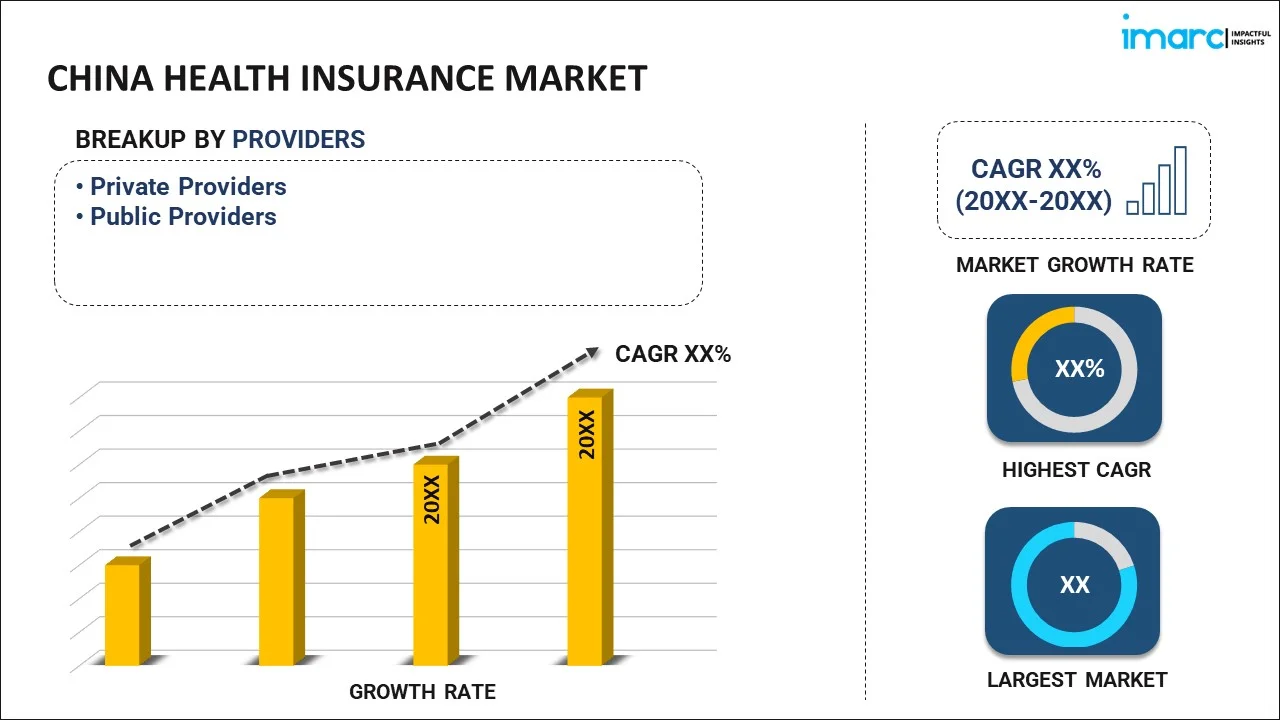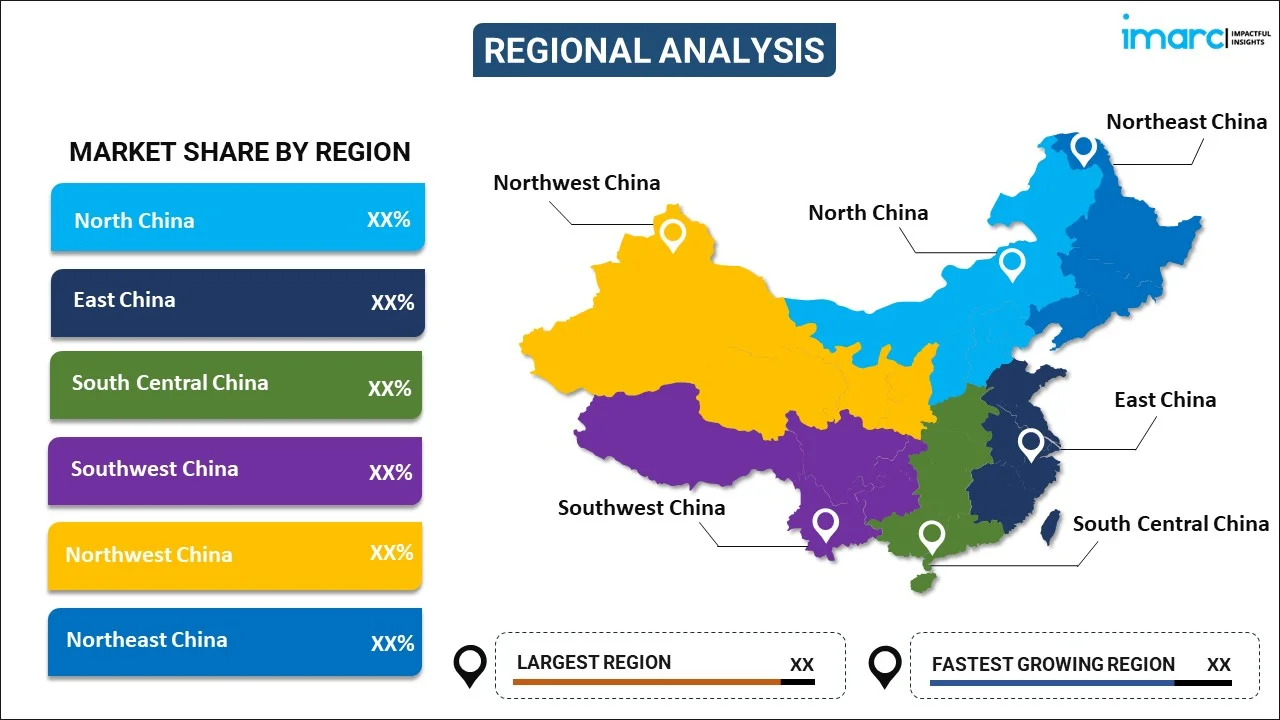
China Health Insurance Market Report by Provider (Private Providers, Public Providers), Type (Life-Time Coverage, Term Insurance), Plan Type (Medical Insurance, Critical Illness Insurance, Family Floater Health Insurance, and Others), Demographics (Minor, Adults, Senior Citizen), Provider Type (Preferred Provider Organizations (PPOs), Point of Service (POS), Health Maintenance Organizations (HMOs), Exclusive Provider Organizations (EPOs)), and Region 2025-2033
China Health Insurance Market Overview:
The China health insurance market size reached USD 321.4 Billion in 2024. Looking forward, IMARC Group expects the market to reach USD 596.1 Billion by 2033, exhibiting a growth rate (CAGR) of 7.10% during 2025-2033. The market is primarily driven by the increasing number of chronic ailments, the widespread adoption of supportive government policies, the growing geriatric population, and the rising demand for higher-quality medical services in China.
|
Report Attribute
|
Key Statistics
|
|---|---|
|
Base Year
|
2024
|
|
Forecast Years
|
2025-2033
|
|
Historical Years
|
2019-2024
|
|
Market Size in 2024
|
USD 321.4 Billion |
|
Market Forecast in 2033
|
USD 596.1 Billion |
| Market Growth Rate 2025-2033 | 7.10% |
China Health Insurance Market Trends:
Increasing Chronic Diseases
The need for health insurance is increasing with the rising number of chronic illnesses in China. Long-term medical treatment is becoming necessary due to the rising prevalence of chronic illnesses including diabetes, cardiovascular disease, and cancer, which is pushing individuals to get health insurance plans for financial security. For instance, according to data from the National Medical Product Administration, in 2023, 11.56 million individuals in China's urban and rural areas received concrete benefits from the country's main sickness insurance program. Under the direction of the National Healthcare Security Administration, this program reduced financial burdens for individuals by an average of 7,924 yuan, or approximately 1,117 US dollars. Additionally, China has established a three-tier healthcare security system comprising basic medical insurance, major disease insurance, and medical assistance to mitigate the economic risks posed by medical expenditure. Moreover, approximately 1 billion people who are already covered by basic medical insurance under this system are immediately eligible for primary illness insurance at no additional cost. Those receiving minimum subsistence allowances, individuals facing special difficulties, and those falling into or slipping back into poverty are entitled to a 5% point increase in the reimbursement rate. Thus, health education campaigns, early detection programs, and improved access to quality healthcare services are influencing the market growth.
Supportive Government Initiative:
The initiative to integrate China's health insurance schemes reflects a strategic move toward a more comprehensive and inclusive healthcare system. For instance, the Chinese government introduced the Healthy China 2030 initiative to ensure universal health security for all its citizens by 2030. Additionally, comprehensive endeavors have been launched to enhance the financial efficiency, effectiveness, and sustainability of the healthcare system. Moreover, there is a concerted focus on bolstering primary care services and enhancing the performance of public hospitals.. Additionally, the Chinese government hopes to guarantee that all residents, irrespective of their financial situation or place of residence, have access to reliable and sufficient coverage by combining several insurance schemes. Furthermore, the government is lowering gaps in healthcare access and streamlining administrative processes for patients and healthcare providers, thus propelling market growth.
China Health Insurance Market News:
- May 2024: The Chinese government has initiated its annual drive to address misconduct within the nation's healthcare sector, including the procurement and sale of medical goods as per the National Health Commission (NHC). The objective of this campaign, as outlined in a document jointly released by 14 government bodies including the NHC, is to standardize the production and distribution processes of medical supplies, eradicate corruption and irregularities, and ensure the integrity of the national medical insurance fund.
- March 2024: Chinese officials announced in a campaign to expand children's access to basic medical insurance. The goal of the project is to safeguard children's rights, welfare, and general well-being across the country. The National Health Commission, the Ministry of Education, and the National Healthcare Security Administration jointly released a circular outlining a goal, by the end of 2024, over 80% of newborns will be enrolled in the national basic medical insurance program during their birth year.
China Health Insurance Market Segmentation:
IMARC Group provides an analysis of the key trends in each segment of the market, along with forecasts at the country level for 2025-2033. Our report has categorized the market based on provider, type, plan type, demographics, and provider type.
Provider Insights:

- Private Providers
- Public Providers
The report has provided a detailed breakup and analysis of the market based on the provider. This includes private providers and public providers.
Type Insights:
- Life-Time Coverage
- Term Insurance
A detailed breakup and analysis of the market based on the type have also been provided in the report. This includes life-time coverage and term insurance.
Plan Type Insights:
- Medical Insurance
- Critical Illness Insurance
- Family Floater Health Insurance
- Others
The report has provided a detailed breakup and analysis of the market based on the plan type. This includes medical insurance, critical illness insurance, family floater health insurance, and others.
Demographics Insights:
- Minor
- Adults
- Senior Citizen
A detailed breakup and analysis of the market based on the demographics have also been provided in the report. This includes minor, adults, and senior citizen.
Provider Type Insights:
- Preferred Provider Organizations (PPOs)
- Point of Service (POS)
- Health Maintenance Organizations (HMOs)
- Exclusive Provider Organizations (EPOs)
The report has provided a detailed breakup and analysis of the market based on the provider type. This includes preferred provider organizations (PPOs), point of service (POS), health maintenance organizations (HMOs), and exclusive provider organizations (EPOs).
Regional Insights:

- North China
- East China
- South Central China
- Southwest China
- Northwest China
- Northeast China
The report has also provided a comprehensive analysis of all the major regional markets, which include North China, East China, South Central China, Southwest China, Northwest China, and Northeast China.
Competitive Landscape:
The market research report has also provided a comprehensive analysis of the competitive landscape. Competitive analysis such as market structure, key player positioning, top winning strategies, competitive dashboard, and company evaluation quadrant has been covered in the report. Also, detailed profiles of all major companies have been provided.
China Health Insurance Market Report Coverage:
| Report Features | Details |
|---|---|
| Base Year of the Analysis | 2024 |
| Historical Period | 2019-2024 |
| Forecast Period | 2025-2033 |
| Units | Billion USD |
| Scope of the Report | Exploration of Historical Trends and Market Outlook, Industry Catalysts and Challenges, Segment-Wise Historical and Future Market Assessment:
|
| Providers Covered | Private Providers, Public Providers |
| Types Covered | Life-Time Coverage, Term Insurance |
| Plan Types Covered | Medical Insurance, Critical Illness Insurance, Family Floater Health Insurance, Others |
| Demographics Covered | Minor, Adults, Senior Citizen |
| Provider Types Covered | Preferred Provider Organizations (PPOS), Point of Service (POS), Health Maintenance Organizations (HMOS), Exclusive Provider Organizations (EPOS) |
| Regions Covered | North China, East China, South Central China, Southwest China, Northwest China, Northeast China |
| Customization Scope | 10% Free Customization |
| Post-Sale Analyst Support | 10-12 Weeks |
| Delivery Format | PDF and Excel through Email (We can also provide the editable version of the report in PPT/Word format on special request) |
Key Questions Answered in This Report:
- How has the China health insurance market performed so far and how will it perform in the coming years?
- What has been the impact of COVID-19 on the China health insurance market?
- What is the breakup of the China health insurance market on the basis of provider?
- What is the breakup of the China health insurance market on the basis of type?
- What is the breakup of the China health insurance market on the basis of plan type?
- What is the breakup of the China health insurance market on the basis of demographics?
- What is the breakup of the China health insurance market on the basis of provider type?
- What are the various stages in the value chain of the China health insurance market?
- What are the key driving factors and challenges in the China health insurance?
- What is the structure of the China health insurance market and who are the key players?
- What is the degree of competition in the China health insurance market?
Key Benefits for Stakeholders:
- IMARC’s industry report offers a comprehensive quantitative analysis of various market segments, historical and current market trends, market forecasts, and dynamics of the China health insurance market from 2019-2033.
- The research report provides the latest information on the market drivers, challenges, and opportunities in the China health insurance market.
- Porter's five forces analysis assist stakeholders in assessing the impact of new entrants, competitive rivalry, supplier power, buyer power, and the threat of substitution. It helps stakeholders to analyze the level of competition within the China health insurance industry and its attractiveness.
- Competitive landscape allows stakeholders to understand their competitive environment and provides an insight into the current positions of key players in the market.
Need more help?
- Speak to our experienced analysts for insights on the current market scenarios.
- Include additional segments and countries to customize the report as per your requirement.
- Gain an unparalleled competitive advantage in your domain by understanding how to utilize the report and positively impacting your operations and revenue.
- For further assistance, please connect with our analysts.
 Request Customization
Request Customization
 Speak to an Analyst
Speak to an Analyst
 Request Brochure
Request Brochure
 Inquire Before Buying
Inquire Before Buying




.webp)




.webp)












